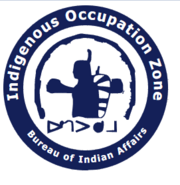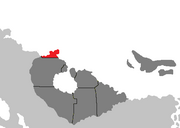Rensselaerswijck Indigenous Occupation Zone
The Rensselaerswijck Indigenous Occupation Zone (Rensselaer Freijian: Rensselaerswijck Inheemse Bezettingszone) is an autonomous territory located within the sovereign borders of the Federal Republic of Rensselaerswijck. The territory was created on January 1st, 1932 by President Willem Lodewijk, who personally championed the idea. The occupation zone provides a large, open expanse of land for natives and indigenous peoples of all kinds to freely live without the restrictions of the Federal Government.
The Occupation Zone is currently home to over 90,000 indigenous peoples, the largest in all of Hibernia. The area is lead by an inter-governmental body of both Rensselaer and Cree officials, with there being two head chiefs of the Department: one from the Federal government and one from the Cree Indian Nation. Before the Rensselaerswjick Indigenous Occupation Zone was created, the land originally was apart of the province of Kanatsiohareke.
Laws of the R.I.O.Z
Federal Government Jurisdiction
Officially, the Federal Government has "minimal to zero" jurisdiction over the territory. However, to avoid issues such as criminals seeking refuge in the zone or possible trespassing / crime, the RIOZ has an unofficial agreement that Federal authorities are allowed to cross to arrest, extradite, or otherwise enforce law. Federal law relating to criminal matters still applies, although all civil law is not in effect. In addition, a vast majority of the budget for the Bureau of Indian Affairs is spent on maintaining the infrastructure of the RIOZ in spots, although a majority of the area is dense woodland. Hunting is illegal across the entire zone for those who do not inhabit it, under punishment of jailtime.
The Federal Government is also allowed to keep track of all official residents of the RIOZ, and all born in the RIOZ still become Rensselaer citizens. The census is still allowed to be conducted in the RIOZ (given it is still operational for the 1940 Census) and records on names, birthplaces, and other information crucial will be collected regularly as well.
Tresspassing and Tourism
The status of non-indigenous peoples and those who are not members of the RIOZ is officially determined by the Cree nation, not the Federal government. The government is obliged to follow and enforce whatever policy of entry they may request, and currently the RIOZ is closed for all foreign visitors. Checkpoints litter the most trafficked points, and most of other areas of entry are dense woodlands which no normal tourist would attempt to trek.
The RIOZ tribal chiefs have indicated in the future they may possibly open up the zone in future to tourism, but questions about when or if this will happen still linger. Multiple tourists have been arrested by illegally tresspassing into the zone to 'take in the culture', and at least one has been charged with jail time due to the occurences.
Already Withstanding Population
Before the RIOZ was created, an obvious issue was that a small number of non-indigenous (and indigenous who did not want to be apart of the RIOZ) lived in the area. The Federal Government first offered payment for property in order for the disputed indivduals to move to somewhere else. If the individuals refused this offer, the government would rebuff allowing them access to the RIOZ while agreeing under oath to not interfere with native affairs and customs. Many individuals refused this, too, claiming they had no reason to do anything that the government asked of them. The last government option was Eminent Domain, and siezed the property forcefully, removing the indivudals and compensating them for their land.
President Lodewijk was apparently furious that the Bureau had envoked Eminent Domain in order to move populations, calling it "government overreach not at all acceptable in a government." He fired the head of the Bureau of the Indian Affairs, and another permanent head has yet to be confirmed by Parliament.
Admission into the RIOZ
The application process for the RIOZ was made straightforward. Applicants only needed to be of indigenous ancestry and willing to conform to whatever local tribe's customs and culture. This has raised questions on what actually defines an indigenous person, as over half of the population has indigenous ancestry from ancestors coming from the foundation of Rensselaerswijck.
Speculation and Controversy
Nationalist Uproar
Nationalist sentiment, generally nonexistent in Rensselaerswijck, made waves decrying the RIOZ as a hostile takeover of rightful Rensselaer land. The envoking of Eminent Domain by the Bureau of Indian Affairs has spawned unconfirmed conspiracy theories of a "Native Conspiracy" to revoke rightful Rensselaer priveleges. While the reception of the RIOZ has been generally positive among the public, the polarization of attitudes surrounding the indigenous question continues to worsen as time goes on.
Usefullness of a Reservation
Some critics have accused the government have making the RIOZ as a ploy to fetch votes from the indigenous voting bloc. They point to the fact that the Rensselaer culture and identity is one of indigenous and Freijian mix. A vast majority of the population has both ancestries, so critics say, a zone specified for indigenous culture is completely unwarranted.
"A reservation means nothing if there is nothing to reserve. What are we trying to preserve here? We aren't eradicating culture or customs as other nations do across this continent. Our identity revolves around embracing indigenous culture, which is what we have already done. There is no reason to further divide us with a population that does not feel the need to go to the ways of old." - Nieuw Hoop Register
Cree nation authorities have rebuffed these opinions, stating that the fact that so many indigenous have flocked to the RIOZ proves it's neccessity in maintaining indigenous culture and identity.
Fairfax Controversy
While talking to a reporter in late December of 1931, Deputy President Hamilton Van Rensselaer Fairfax remarked that had he been President, "this occupation zone idea would have never gotten past my desk." This comment had made waves throughout the nation, with reporters questioning if the government was truly on one page and in agreement. A few days later, the Deputy President walked back the comments, stating: "I completely follow and agree with my co-partner's agenda of the RIOZ. Cooperation is key in a co-led government like ours, and it is that which we must follow. I am not walking back: I personally do not believe a reservation is in the interests of indigenous people's, but it is in the spirit of compromise in which we follow. Rest assured, the government is in full agreement."
The party leaders of opposition parties called the Deputy President a "sell-out" for not standing up for his own values, and the perception had stuck for a short time until the Deputy President motioned for a Censure vote on Maurus Schaaf, leader of the Rural Interests Bloc, and vocal critic of the administration. It passed in quick fashion with the support of the Coalition Government, and other leaders in Parliament dropped the matter in what the lone Socialist Front member of parliament Neents Brouwer called a "silencing of democracy" and "further reason the Federal government must be reformed to serve the proletariat."

